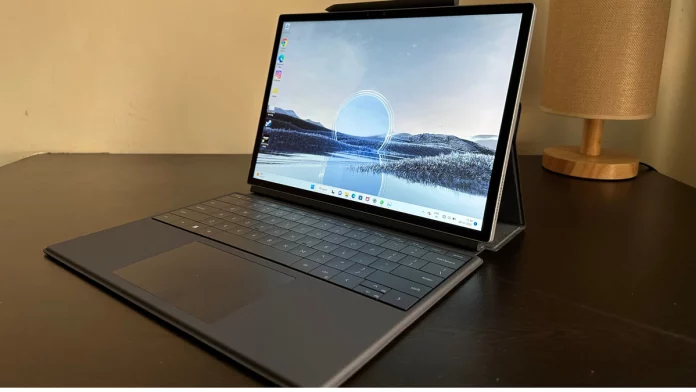We stated it again in our most recent Surface Pro 9 Intel edition review: Microsoft’s recipe has long been mimicked, but never equaled. This type of tablet is used mostly as a laptop in an unusual format, with a design that works without being able to explain why.
Professionals were attracted years ago, despite the fact that it is the domain of a brand like Dell. No surprise, therefore, that it is attempting to compete with the developer of Windows once more with its new XPS 13 2-in-1.
TECHNICAL SHEET
| Model | Dell XPS 13 2-in-1 (9315) |
|---|---|
| Screen size | 13 inches |
| Definition | 2880 x 1920 pixels |
| Display technology | LCD |
| Touchscreen | Oui |
| Processor (CPU) | Core i5-1230U |
| Graphics chip (GPU) | intel Iris Xe |
| Memory (RAM) | 16 Go |
| Internal memory | 512 Go |
| Wi-Fi standards | Wi-Fi 6E |
| Version du Bluetooth | 5.2 |
| Operating system (OS) | Microsoft Windows 11 |
| Dimensions | 201,20 x 7,40 x 292,50 mm |
| Weight | 736 grammes |
| Repairability Index? | 4,7/10 |
| Price | 1649 $ |
DESIGN
Comparisons to the Surface Pro are unavoidable because Microsoft products are the market standard in this category. The Dell XPS 13 2-in-1, on the other hand, does not have nearly the same look and is more in line with the popular XPS models. We do have a 13-inch tablet with a 3:2 ratio, which has become the direct competitor’s big characteristic, but the device’s forms are much more rectangular, much more industrial. Its metal chassis is significantly more rough and less smooth to the touch.

But, most importantly, it is a true rectangle. There is no heat evacuation on the latter, as opposed to the Surface Pro, which has a type of “gutter” all around the device to allow hot air to leave through active cooling. This detail will be crucial later, but in terms of design, it is efficient. You have to enjoy this industrial, cold, metallic language, but it’s a pleasure of engineering that we have in front of our eyes and beneath our fingertips.


The main distinction is in the design of the gadget with its keyboard. The Dell XPS 13 2-in-1 is plainly built to be a Windows tablet first and foremost, rather than the strange hybrid that Surface has managed to promote. The magnetic keyboard, which attaches through pogo connections, resembles that of traditional tablets, whether running Android or iOS, and it is also because to this “pocket” that we can hold the device upright. The lower part of the rear of the XPS 13 2-in-1 is magnetic, allowing you to specify the angle at which the screen will be orientated.

It’s nowhere near as effective as the adjustable foot incorporated into the Surface design, and it has significantly fewer configuration options. Faced with a direct adversary capable of contorting itself in a matter of seconds, we are more in the “passable” category.
read also : The Snapdragon 8cx Gen 4 would compete Apple M2 Pro!
KEYBOARD AND TOUCHPAD
Let’s discuss about that renowned keyboard. The Dell XPS 13 2-in-1’s detachable keyboard is identical to that of the Dell XPS 13 Plus, with big keys positioned close to each other. The comfort level will vary greatly depending on who is using it; personally, I have no issues with this keyboard. It has the slightly soft rebound that we expect from this type of design, but it is still comfortable enough to be worn on a regular basis without effort. The same can be said for the plastic-coated touchpad.

What is more restricting is the fact that this keyboard must be used flat. Unlike the Surface Pro, Dell has not included a magnet on the front of the device to allow for a little tilt of the keyboard to improve ergonomics. A flat keyboard can suffice for one or two hours, but you will quickly feel it in your hands. The editor’s choice.
CONNECTORS
It’ll be lightning fast: just two Thunderbolt 4 ports on the left side. That’s fine from the standpoint of a tablet. From the standpoint of a laptop, that’s pretty little. When compared to the Surface Pro… The latter has the “merit” of having its own proprietary charging connector, which is only useful in this case.
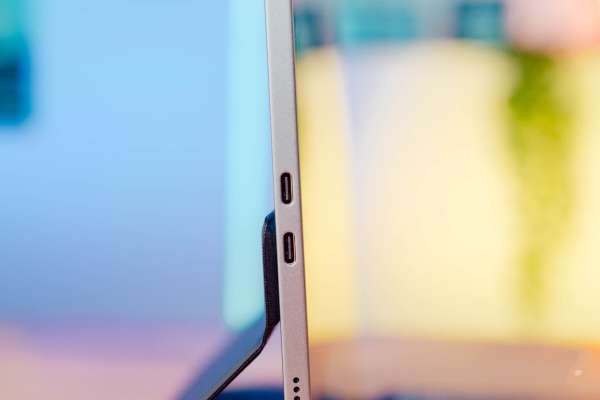
We will thus suffice it to remark that we would have welcomed having a connector on either side of the Dell XPS 13 2-in-1 so that we could easily adjust to any circumstance. On the other hand, you get a power button as well as a fingerprint scanner, which is a nice feature to have while using a tablet.
WEBCAM & AUDIO
The Dell XPS 13 2-in-1, like many other devices of its sort, includes a front and back camera to allow information exchange during a video conference. Having stated that… Dell’s processor is extremely outstanding, placing it well ahead of any other Windows device in this regard. The front-facing camera is still compatible with Windows Hello, providing two means of biometric authentication on a single device.
One speaker on the left and one on the right provide full stereo sound that is nicely defined for such a compact gadget. What we will most lament about the Dell XPS 13 2-in-1’s audio arrangement is the lack of loudness. The sound is decent, but not too loud.
SCREEN
The Dell XPS 13 2-in-1 has a 13-inch IPS LCD display with a 3:2 aspect ratio and a 3K resolution of 2880 by 1920 pixels. This display has a refresh rate of 60Hz and is made of Gorilla Glass 7 glass.
We can see that our probe and the DisplayCal software cover 101.4% of the sRGB space, 71.8% of the DCI P3 area, and 69.9% of the Adobe RGB space. The maximum brightness is increased to 501 cd/m2, which is precisely what the manufacturer claims, giving a superb contrast ratio of 1888:1.
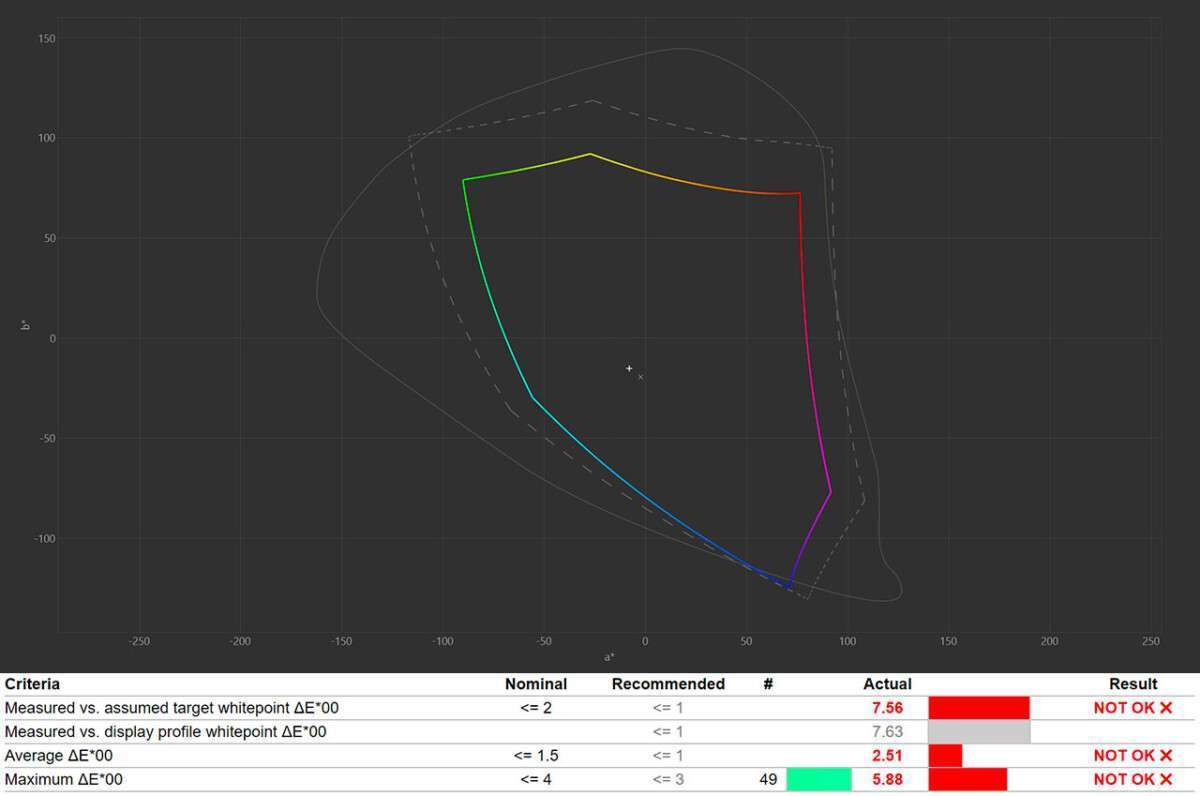
In our observations, we notice an outstanding average color temperature of 6492K, which corresponds to the NTSC standard of 6500K, but with an average Delta E00 of 2.51 when considering the DCI P3 space. Returning to the sRGB region, the average Delta E00 is then measured at a superb 1.15.
The conclusion is straightforward: the Dell XPS 13 2-in-1 features an excellent sRGB-calibrated screen. Excellent work. The main disappointment is that it is not calibrated for the DCI P3, which is becoming increasingly popular. Creatives, on the other hand, may certainly rely on this machine for their works.
SOFTWARE
If only Dell had not installed McAfee, that pesky adware. We can’t blame him, though, because he’s not the only one on the market. Aside from that, the monitoring software provided by the manufacturer is not very aesthetically appealing, but it provides precisely what is anticipated of a computer’s daily management: enough to effectively update its drivers and regulate computer performance.
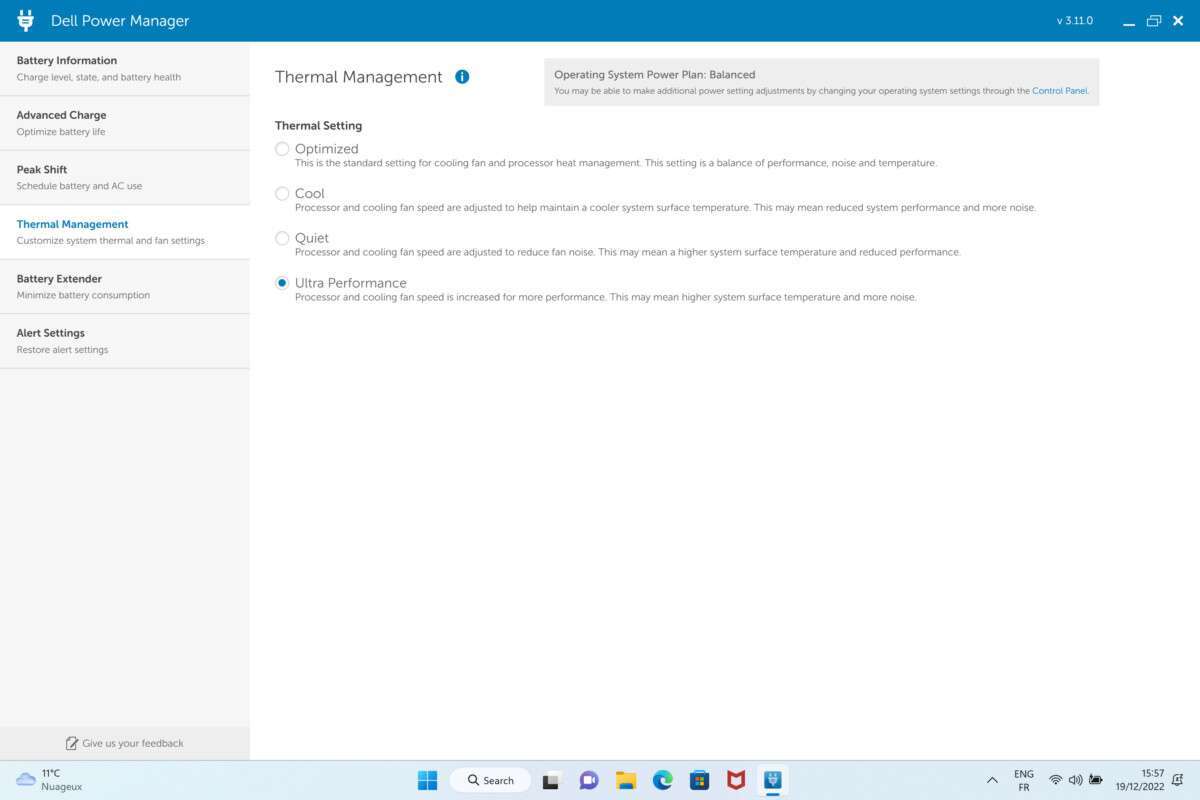
To truly unlock the device’s raw performance, though, it will be essential to alter it in both Dell’s Power Management program and the Windows system settings. This duplication is unfortunate, but most people will never touch these options. Also, if the Dell XPS 13 2-in-1 is indeed intended to be used mostly as a tablet, it should be mentioned that Windows 11 is considerably more pleasant in this context than previous versions… but it is not the same. The height of an OS designed specifically for this purpose. A stylus would be practically necessary on a regular basis to attain true comfort of usage.
PERFORMANCES
Our Dell XPS 13 2-in-1 is powered by the Intel Core i7-1250U, a 12th generation Intel SoC with 10 cores (2 performance and 8 efficiency) with a turbo speed of up to 4.7 GHz. It’s accompanied with 16 GB of LPDDR5 RAM and 1 TB of PCIe 4.0 storage.
Check also : The big transformation of apple in 2023
BENCHMARKS AND HEATING
The most astute ag4tech readers would have observed that, instead of two distinct points as is customary, we have gathered here our notes on benchmarks and device heating. It’s quite natural here, because it’s hard to discuss the Dell XPS 13 2-in-1’s performance without noting its heat management.
By pushing the Dell XPS 13 2-in-1’s performance to the limit in Cinebench R23, we get a final score of 4433 points in multi core and 1186 points in single core. On PCMark 10, this translates to a total score of 4331. It is quite little for this configuration: we are used to this chip and so score about 7000/1600 rather than the 4400/1200 seen here.
The explanation is straightforward: heat throttling is highly noticeable on this device. This is a normal computer behavior: if the heat is too great, the computer will automatically reduce its performance to heat less and protect its components. It’s just not an option for the Dell XPS 13 2-in-1. Above important, its performance does not accurately reflect Intel’s setup.
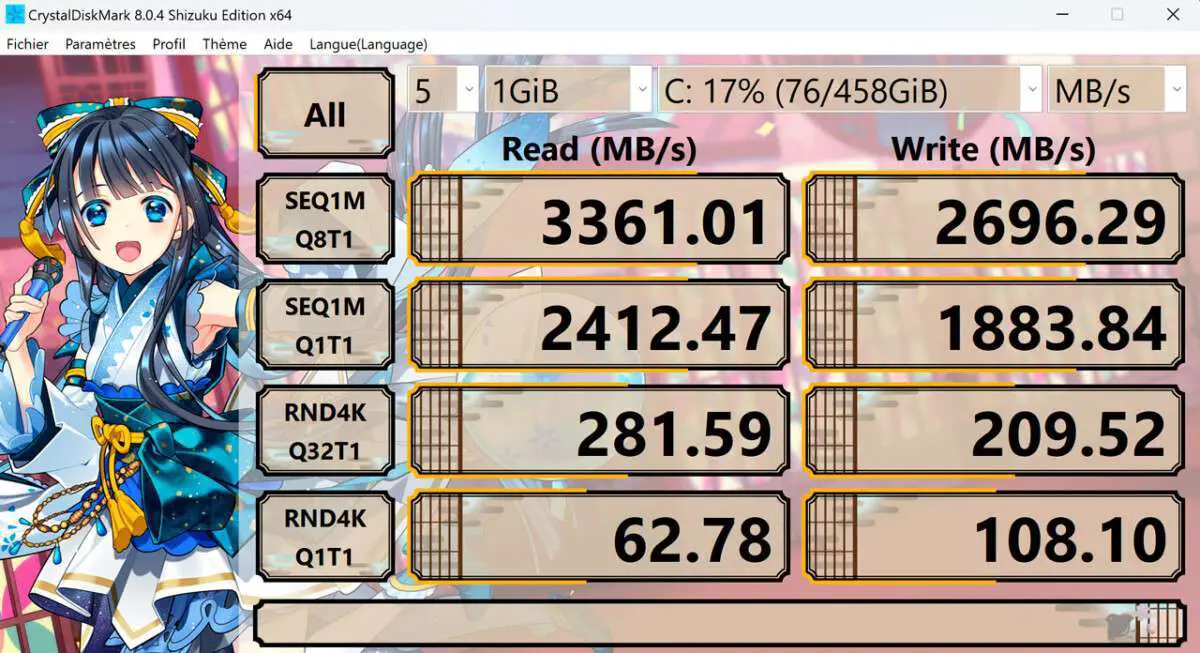
Thermal throttling also affects the Surface Pro. As previously said, this is very typical. However, its sustained performance remains good due to active cooling of its components. This is not the case with the Dell XPS 13 2-in-1: the cooling is passive. It, like a traditional tablet, depends on its chassis to disperse heat. Except that we’re not dealing with an ARM SoC here, but rather a standard x86-64 with considerably more obvious heating. When pushed to its limit, the Dell XPS 13 2-in-1 reaches a disconcerting temperature of 45°C at both the front and rear. These high temperatures are not common in everyday usage, but they are achievable.



So, why have an Intel Core integrated? For its performance during brief bursts of use, or “bursts,” as they are commonly referred as. The Dell XPS 13 2-in-1 will not be your greatest buddy when it comes to continuous performance applications, such as rendering a movie or an intensive graphic. It’s reasonable to assume that the manufacturer is looking forward to an ARM platform on Windows that delivers on its promises.
Dell’s method does have one advantage: perfect quiet in any event, and maybe reduced danger of mechanical failure without a fan beneath the hood.
AUTONOMY
The Dell XPS 13 2-in-1 is extremely slim. As a result, it’s not unexpected that it only has a 49.5Wh battery, which is enough for a tablet of this size. It is charged through its USB C connections with a 45W PowerDelivery charger.
In a true office setting, the laptop dies after 5 to 6 hours of use. With more moderate tablet use, more internet, and more entertainment, we turn around 7 to 8 hours, which is already much more acceptable.
You would have realized that the Dell XPS 13 2-in-1’s 2-in-1 configuration virtually works against it in terms of autonomy. It’s not a nice laptop, but it’s a decent tablet on Windows 11… if we’re searching for a tablet with this OS.
PRICE AND AVAILABILITY
The Dell XPS 13 2-in-1 is already available, where it is marketed as a bundle with its cover/keyboard for 1649 dollars.


